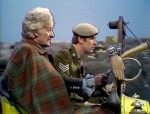 The use of ‘green screen’ in the production of Doctor Who has been significant, based upon the technology of replacing a specific colour with a background or model to create a visual which may not be achievable for practical or budgetary reasons. ‘Green screen’ has since been used in a myriad of other productions including motion picture franchises such as, Harry Potter and Star Wars, but also for TV weather forecast bulletins, for example. However, Doctor Who is a programme which has always been innovative and at the beginning of the 1970’s the technique was first being utilised by the production team.
The use of ‘green screen’ in the production of Doctor Who has been significant, based upon the technology of replacing a specific colour with a background or model to create a visual which may not be achievable for practical or budgetary reasons. ‘Green screen’ has since been used in a myriad of other productions including motion picture franchises such as, Harry Potter and Star Wars, but also for TV weather forecast bulletins, for example. However, Doctor Who is a programme which has always been innovative and at the beginning of the 1970’s the technique was first being utilised by the production team.
Barry Letts, Doctor Who’s producer from 1969 to 1974 championed the special effects procedure, known as ‘Colour Separation Overlay’ or ‘CSO’. Whilst today the technique utilises a distinctive green colour, back then the colour was often blue or occasionally yellow. These three colours are used because they do not include tones found in human skin so an actor’s features wouldn’t be lost. The technique involves the separation of the background colour from the shot and overlaying a different image, or more simply the colour is ‘keyed out’ hence the technique’s alternate name ‘chroma key’. Different images used can vary, from two-dimensional matte paintings to 3-dimensional models. For instance, the actors may be on one part of the studio whilst in another corner a second camera is pointed at a miniature model. The two shots once mixed together are then recorded live.




The first use of CSO in Doctor Who came in the 1970 story ‘The Silurians’ including for the reveal of the Tyrannosaurus and was frequently used from then onwards. Other classic Doctor Who episodes with notable CSO usage include the maggots and giant fly attack in ‘The Green Death’ (1973), the Exillon City in ‘Death to the Daleks’ (1974) and ‘Invasion of the Dinosaurs’ (1974) with the model dinosaurs being inserted into live action sequences. A similar version of this method can be seen in ‘The Fires of Pompeii’ (2008) to create the shot of the Doctor using his water pistol on the Pyroville. This however, was done digitally as technology has developed but the principle remains the same. The technique can also be used for effects such as something growing, for example, Azal in ‘The Daemons’ (1972) and the K1 Robot in ‘Robot’ (1974).
A notable story which utilised CSO extensively was ‘Underworld’ (1978). For severe budgetary reasons it was not possible to build full size sets needed for some scenes. As a result CSO was used to create the cave scenes of the alien planet, with a significant portion of the studio being only a blue background wall and floor, testing the actors and production team to the limit. This was a technique which had also been used during the filming of ‘Terror of the Autons’ (1971) where CSO was used as a background instead of constructing sets. The process would continue to be used in the 1980’s for stories such as ‘Meglos’ (1980) and ‘Time Flight’ (1982). The success of these effects over the years on Doctor Who is varied and the use of CSO is often noticeable by flaring or fuzzy edges but as technology has improved generally so have CSO techniques.
 Now into the 21st Century the Doctor Who production team still utilise ‘green screen’ technology, with more complicated effects such as the Werewolf in ‘Tooth and Claw’ (2006) and the headless and armless Cyberman from ‘The Pandorica Opens’ (2010) achieved using the same theory. Similarly, the shark-pulled flying rickshaw in ‘A Christmas Carol’ (2010), shots for ‘The Rings of Akhaten’ (2013) and even David Tennant’s final recording on his original run as the Doctor was conducted on ‘green screen’ for ‘The End of Time: Part 2’. Therefore it seems likely that Doctor Who will forever continue to use ‘green screen’ in the production of the show.
Now into the 21st Century the Doctor Who production team still utilise ‘green screen’ technology, with more complicated effects such as the Werewolf in ‘Tooth and Claw’ (2006) and the headless and armless Cyberman from ‘The Pandorica Opens’ (2010) achieved using the same theory. Similarly, the shark-pulled flying rickshaw in ‘A Christmas Carol’ (2010), shots for ‘The Rings of Akhaten’ (2013) and even David Tennant’s final recording on his original run as the Doctor was conducted on ‘green screen’ for ‘The End of Time: Part 2’. Therefore it seems likely that Doctor Who will forever continue to use ‘green screen’ in the production of the show.



